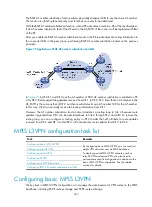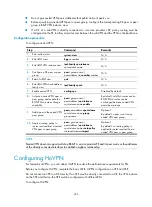
254
Step Command
Remarks
2.
Create an OSPF process for a
VPN instance and enter the
OSPF view.
ospf
[
process-id
|
router-id
router-id
|
vpn-instance
vpn-instance-name
] *
Perform the configurations on PEs.
On CEs, create a normal OSPF
process.
3.
Configure the OSPF domain
ID.
domain-id
domain-id
[
secondary
]
Optional.
0 by default.
4.
Configure the type codes of
OSPF extended community
attributes.
ext-community-type
{
domain-id
type-code1
|
router-id
type-code2
|
route-type
type-code3
}
Optional.
The defaults are as follows:
•
0x0005 for Domain ID
•
0x0107 for Router ID
•
0x0306 for Route Type
Perform this configuration on PEs.
5.
Create an OSPF area and
enter area view.
area
area-id
By default, no OSPF area is
created.
6.
Enable OSPF on the interface
attached to the specified
network in the area.
network
ip-address wildcard-mask
By default, an interface neither
belongs to any area nor runs
OSPF.
NOTE:
Deleting a VPN instance also deletes all the associated OSPF processes.
An OSPF process can be configured with only one domain ID. Domain IDs of different OSPF processes
are independent of each other.
All OSPF processes of a VPN must be configured with the same domain ID for routes to be correctly
advertised, while OSPF processes on PEs in different VPNs can be configured with domain IDs as
desired.
The domain ID of an OSPF process is included in the routes generated by the process. When an OSPF
route is redistributed into BGP, the OSPF domain ID is included in the BGP VPN route and delivered as
a BGP extended community attribute.
For more information about OSPF, see
Layer 3—IP Routing Configuration Guide
.
Configuring IS-IS between PE and CE
An IS-IS process belongs to the public network or a single VPN instance. If you create an IS-IS process
without binding it to a VPN instance, the process belongs to the public network.
For more information about IS-IS, see
Layer 3—IP Routing Configuration Guide
.
To configure PE-CE route exchange through IS-IS:
Step Command
Remarks
1.
Enter system view.
system-view
N/A
2.
Create an IS-IS process for a
VPN instance and enter IS-IS
view.
isis
[
process-id
]
vpn-instance
vpn-instance-name
N/A
3.
Configure a network entity
title for the IS-IS process.
network-entity
net
Not configured by default.
4.
Return to system view.
quit
N/A
















































